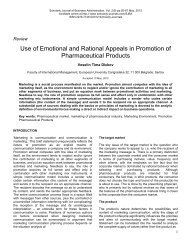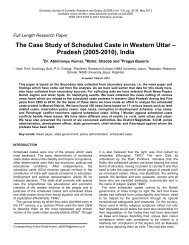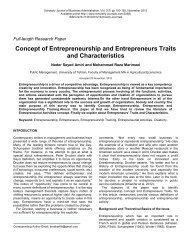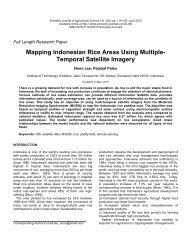computer simulation for inventory control - Scholarly Journals
computer simulation for inventory control - Scholarly Journals
computer simulation for inventory control - Scholarly Journals
Create successful ePaper yourself
Turn your PDF publications into a flip-book with our unique Google optimized e-Paper software.
Full Length Research Paper<br />
<strong>Scholarly</strong> Journal of Mathematics and Computer Science Vol. 1(1), pp. 1-5, March 2012<br />
Available online at http:// www.scholarly-journals.com/SJMCS<br />
ISSN 2276-8947 ©2012 <strong>Scholarly</strong>-<strong>Journals</strong><br />
COMPUTER SIMULATION FOR INVENTORY CONTROL<br />
Gbolagade K. Adegoke 1 , A. J. Jegede 2 , N. I. Akosu 3<br />
1Department of Mathematical Sciences, (Computer Science Unit), Faculty of Natural and Applied Sciences, Nasarawa State University, Keffi Along<br />
Abuja/Akwanga Highway, P. M. B 1022, Keffi Nasarawa State.<br />
2Dept. of Computer Science University of Jos, Jos Plateau State Nigeria.<br />
3Dept. of Computer Science Federal Polytechnic Nasarawa, Nasarawa State Nigeria.<br />
Accepted 8 August, 2011<br />
This study concerns the role of <strong>computer</strong> <strong>simulation</strong> as a device <strong>for</strong> conducting scientific experiments<br />
on <strong>inventory</strong> <strong>control</strong>. The stores function utilizes a bulk of physical assets and engages a bulk of<br />
financial resources in a manufacturing outfit there<strong>for</strong>e there is a need <strong>for</strong> an efficient <strong>inventory</strong> <strong>control</strong>.<br />
The reason being that <strong>inventory</strong> <strong>control</strong> reduces cost of production and thereby facilitates the effective<br />
and efficient accomplishment of production objectives of an organization. Some mathematical and<br />
statistical models were used to compute the Economic Order Quantity (EOQ). Test data were gotten<br />
from a manufacturing company and same were simulated. The results generated were used to predict a<br />
real life situation and have been presented and discussed. The language of implementation of the model<br />
is Turbo Pascal due to its capability and flexibility as a scientific programming language.<br />
Key words: Simulation, model, <strong>inventory</strong>, economic order quantity, <strong>control</strong>, manufacturing.<br />
INTRODUCTION<br />
Simulation can be defined as a numerical technique <strong>for</strong><br />
conducting experiments on a digital <strong>computer</strong>, which<br />
involves certain types of mathematical and logical models<br />
that describe the behavior of a business or economic<br />
system (or some components thereof) over extended<br />
periods of real time while a model can be defined as an<br />
object or concept that is used to represent something<br />
else. It is readily scaled down and converted to a <strong>for</strong>m<br />
that we can comprehend (Neelamkevil, 1987).<br />
Economic order quantity is the level of <strong>inventory</strong> that<br />
minimizes total <strong>inventory</strong> holding costs and ordering<br />
costs. It is one of the oldest classical production<br />
scheduling models. The framework used to determine<br />
this order quantity is also known as Wilson EOQ Model or<br />
Wilson Formula. The model was developed by F. W.<br />
Harris in 1913, but R. H. Wilson, a consultant who<br />
applied it extensively, is given credit <strong>for</strong> his in-depth<br />
analysis (Hax and Candea, 1984).<br />
Correspondind Author Email: adegokegkola@yahoo.com<br />
1<br />
The following assumptions are usually made, viz;<br />
a) The ordering cost is constant.<br />
b) The rate of demand is constant<br />
c) The lead time is fixed<br />
d) The purchase price of the item is constant, that is, no<br />
discount is available<br />
e) The replenishment is made instantaneously, that is,<br />
the whole batch is delivered at once.<br />
Many companies fail each year due to inadequate <strong>control</strong><br />
of their <strong>inventory</strong>. Inventory could be classified as raw<br />
materials (e.g components, fuels etc.) used to<br />
manufacture products, finished products, ready <strong>for</strong> final<br />
users or work-in-progress (WIP) that is, partly finished<br />
goods and materials, sub-assemblies etc. held between<br />
manufacturing stages.<br />
Inventory problems can arise if too many items are held<br />
in <strong>inventory</strong> either because we increase the <strong>inventory</strong><br />
level of items with high activity (that is, those that are in<br />
high demand) or tend to ignore those with low activity<br />
(that is, those with slow use, or low sale) with the<br />
attendant result that: money is tied up in unnecessary<br />
<strong>inventory</strong>, valuable space is used unnecessarily and the<br />
items may depreciate, deteriorate or even become
Adegoke et al. 2<br />
Table C1. Results on EOQ Model 1.<br />
Item no Annual Usage amount Ordering cost Storage cost EOQ<br />
1 1000.00 50.00 0 .2 707<br />
2 2624.00 455.00 0.20 3455<br />
3 2150.00 450.00 0.20 3110<br />
4 5234.00 670.00 0.20 5922<br />
5 3500.00 500.00 0.20 4183<br />
6 1000.00 50.00 0.20 707<br />
7 3020.00 450.00 0.20 3686<br />
8 3150.00 560.00 0.20 4200<br />
9 5200.00 875.00 0.20 6745<br />
10 154000.00 5000.00 0.20 87750<br />
11 230000.00 8500.00 0.20 139821<br />
12 3426580.00 50000.00 0.20 1308927<br />
Table C2. Results on EOQ Model 2.<br />
Item no Annual usage Ordering cost Storage cost Unit cost EOQ<br />
1 5600 940.00 0.20 120.00 662<br />
2 3280 582.00 0.20 235.00 285<br />
3 7000 1200.00 0.20 320.00 512<br />
4 5400 1980.00 0.20 328.00 571<br />
5 3520 2600.20 0.20 280.00 572<br />
6 5000 3050.00 0.20 450.00 582<br />
7 6500 4000.00 0.20 530.50 700<br />
8 5400 285.00 0.20 420.00 19<br />
9 8520 1970.00 0.20 325.35 718<br />
10 3450 255.00 0.20 12.40 842<br />
11 7380 3200.00 0.20 527.00 669<br />
12 5900 2000.00 0.20 35.00 1836<br />
obsolete (Morrison, 1981).<br />
Inventory problems can also arise if too few items are<br />
held in <strong>inventory</strong>, resulting in loss of profits due to loss of<br />
sales, and due to loss of goodwill consequent upon the<br />
unfilled demands. Stock out (i.e cost due to lack of goods<br />
demanded) may result incurring additional manpower<br />
and/or costs, actual cost to replenish <strong>inventory</strong> stock may<br />
be excessive because stock must be ordered frequently<br />
and the manufacturing plant being shut down as a result<br />
of lack of raw materials to work with (Burton, 1980)<br />
Stock represents an investment to the organization. As<br />
with any other investment, the cost of holding stock must<br />
be related to the benefits to be gained. Hence the<br />
following costs are associated with <strong>inventory</strong>: carrying<br />
cost or <strong>inventory</strong> holding cost, ordering costs and stock<br />
out costs.<br />
Another important element of <strong>inventory</strong> <strong>control</strong> is called<br />
1<br />
reorder point. Businesses need to think ahead and<br />
calculate the best time <strong>for</strong> reordering products. Doing so<br />
too soon may cause financial difficulties or running out of<br />
space. On the other hand, waiting too long to reorder will<br />
result in a shortage and running out of <strong>inventory</strong> be<strong>for</strong>e<br />
the next shipment arrives. When figuring out a reorder<br />
point, it’s necessary to calculate how long it will take the<br />
shipment to arrive and the amount of demand <strong>for</strong> a<br />
particular item. The overhead cost, fees, and shipping<br />
expenses of ordering large versus small quantities should<br />
also be looked at. (Stanojevic and Laing, 2009).<br />
Economic order quantity (EOQ) is the ordering quantity<br />
which minimizes the balance of costs between <strong>inventory</strong><br />
holding costs and reorder costs. Stock <strong>control</strong> usually<br />
strikes balance between overstocking and understocking,<br />
that is. It eliminates the problems associated with<br />
overstocking and understocking (Batty, 1979)
METHODOLOGY<br />
Table C3. Results on EOQ Model 3.<br />
1<br />
<strong>Scholarly</strong> J. Math. Comp. Sci. 3<br />
Item no Ordering cost Annual demand Annual holding cost per Unit U/A EOQ<br />
1 1200.00 1460 4.00 0.75 1324<br />
2 1000.00 730 3.00 0.5 973<br />
3 1500.00 1095 5.50 0.6 1222<br />
4 650.00 1642 4.20 0.67 1235<br />
5 1750.00 912 6.50 0.67 1215<br />
6 2000.60 1095 3.50 0.33 1370<br />
7 950.75 2190 7.25 83 1856<br />
8 2500.65 1 460 13.50 0.75 1471<br />
9 3400.15 2555 10.75 0.86 3364<br />
10 4200.25 1095 10.30 0.2 2113<br />
11 3500.85 1643 015.90 0.83 4341<br />
12 5100.40 2920 25.10 0.88 30.81<br />
Computer programs were developed <strong>for</strong> the three models<br />
represented as programs EOQ1 (Appendix A), EOQ2 (Appendix B)<br />
and EOQ3 (Appendix C) respectively in Turbo Pascal programming<br />
language.<br />
In case of EOQ Model 1, the following input parameters were read<br />
into the <strong>computer</strong> namely: stock item number, annual usage<br />
amount, ordering cost and storage cost while the economic order<br />
quantity <strong>for</strong> some stock items were generated using the developed<br />
<strong>computer</strong> program (Table C1).<br />
Similarly, In case of EOQ Model 2, the following input parameters<br />
were read into the <strong>computer</strong> namely: stock item number, annual<br />
usage quantity, ordering cost, storage cost and unit cost while the<br />
economic order quantity <strong>for</strong> some stock items were generated using<br />
the developed <strong>computer</strong> program (Table C2).<br />
Also, In case of EOQ Model 3, the following input parameters were<br />
read into the <strong>computer</strong> namely: stock item number, arrival rate of an<br />
order, use or sale rate, annual usage quantity, ordering cost,<br />
storage cost and unit cost while the economic order quantity <strong>for</strong><br />
some stock items were generated by <strong>computer</strong> using the developed<br />
<strong>computer</strong> program (Table C3).<br />
Inventory problems are usually concerned with the determination of<br />
order quantities and re-order points bearing in mind the associated<br />
constraints like delays, stock-outs, lead-time, storage etc. The<br />
following costs are usually said to be minimized:<br />
i Carrying costs<br />
ii Ordering cost and<br />
iii Storage cost<br />
Three programs (one <strong>for</strong> each model) were written to calculate the<br />
economic order quantity of some production items using the<br />
mathematical models below:<br />
EOQ Model 1<br />
2 AS<br />
EOQ =<br />
I<br />
A = the annual usage, in Naira<br />
S = the ordering cost, in Naira<br />
I = the <strong>inventory</strong>-carrying cost, as a decimal fraction per Naira<br />
average <strong>inventory</strong><br />
2S<br />
I<br />
EOQ = X A � K A<br />
K =<br />
.A1<br />
2 S<br />
A2<br />
I<br />
where k is a constant which is calculated <strong>for</strong> all items and is then<br />
multiplied by the square root of the annual usage in Naira to<br />
determine the Economic Order Quantity (EOQ) <strong>for</strong> each item.<br />
The results obtained after running the Pascal program is shown in<br />
Table C1 below.<br />
EOQ Model 2<br />
EOQ =<br />
2US<br />
IC<br />
where, U = annual usage in pieces<br />
S = ordering or setup cost, in Naira<br />
I = Inventory – carrying cost, as a decimal fraction per Naira of<br />
average <strong>inventory</strong>.<br />
C = unit cost, in Naira per piece.<br />
The results obtained after running the Pascal program is shown in<br />
Table C2 below.<br />
EOQ Model 3<br />
EOQ =<br />
2C0<br />
D<br />
C1(<br />
1�<br />
U )<br />
A<br />
where, A = arrival rate of an order in unit/day<br />
U = use or sale rate in unit/day<br />
D = annual demand /usage<br />
C0 = Inventory – carrying cost/order<br />
.A3<br />
.A4
Adegoke et al. 4<br />
C1 = annual <strong>inventory</strong> holding cost/unit.<br />
The results obtained after running the Pascal program is shown in<br />
Table C3.<br />
RESULTS AND DISCUSSIONS<br />
The results are presented in tabular <strong>for</strong>m in tables C1, C2<br />
and C3 below.<br />
It is always useful to know the optimal quantity of items<br />
to store in order to minimize expenses. Economic Order<br />
Quantity (EOQ) per<strong>for</strong>ms analogous functions to<br />
<strong>inventory</strong> <strong>control</strong>.<br />
Economic Order Quantity (EOQ) is used <strong>for</strong> material<br />
allocation to process, storage and <strong>inventory</strong> <strong>control</strong>. The<br />
<strong>inventory</strong> costs are usually minimized while the problems<br />
associated with overstocking, stock outs and ordering are<br />
drastically eliminated.<br />
Inventory <strong>control</strong> is the means by which material of the<br />
correct quantity and quality is made available as and<br />
when required, with due regard to economy in storage<br />
cost, ordering costs, purchase prices and working capital.<br />
It is possible to adjust continuously the quantity and value<br />
of stock held to con<strong>for</strong>m to circumstances at all times.<br />
CONCLUSION<br />
Computer <strong>simulation</strong> should be seriously considered and<br />
favoured as a very important tool <strong>for</strong> the industry<br />
especially, in the area of <strong>inventory</strong> <strong>control</strong>. Simulation is a<br />
universal and important tool because it promotes<br />
automation and the success of industrialization depends<br />
largely on it there<strong>for</strong>e it should not be relegated to the<br />
background.<br />
Stock <strong>control</strong> should be embraced by every organization<br />
so as to minimize operating costs.<br />
Inventory <strong>control</strong> usually ensures effective and efficient<br />
utilization of assets of an organization, such as, raw<br />
materials, components, spare parts, tools, work-inprogress,<br />
consumables etc. and also paves way <strong>for</strong> the<br />
creation of valuable and quality product on schedule and<br />
at minimum cost. It arrests the situation of overstocking<br />
which usually leads to high operating cost and that of<br />
understocking which usually leads to loss of sales and<br />
goodwill on the part of an organization.<br />
Appendix A<br />
EOQ1<br />
Program EOQ1(input,output);<br />
var itemno, j : integer;<br />
1<br />
var annualusageamount, orderingcost, storagecost,<br />
EOQ: real;<br />
begin<br />
writeln('Enter the following: itemno,<br />
annualusageamount, orderingcost, storagecost');<br />
writeln('or Press Ctrl + C to stop.');<br />
<strong>for</strong> j := 1 to 12 do<br />
begin<br />
read(itemno, annualusageamount, orderingcost,<br />
storagecost);<br />
EOQ := sqrt((2 * annualusageamount * orderingcost)/<br />
(storagecost));<br />
writeln('Itemno Annualusageamount Orderingcost<br />
Storagecost EOQ');<br />
writeln(Itemno:2, Annualusageamount:13:2,<br />
Orderingcost:14:2, Storagecost:10:2);<br />
writeln(EOQ:10:2);<br />
end;<br />
end.<br />
Appendix B<br />
EOQ2<br />
Program EOQ2(input , output);<br />
const max = 10;<br />
var j, itemno, annualusage: integer;<br />
var orderingcost, storagecost, unitcost, EOQ : real;<br />
begin<br />
writeln;<br />
writeln('Enter the value of the following: Itemno,<br />
annualusage, orderingcost');<br />
writeln('Enter the value of the following: storagecost,<br />
unitcost');<br />
<strong>for</strong> j := 1 to 12 do<br />
begin<br />
read(itemno, annualusage, orderingcost, storagecost,<br />
unitcost);<br />
EOQ := sqrt((2 * annualusage *<br />
orderingcost)/(storagecost * unitcost));<br />
writeln('itemno annualusage orderingcost storagecost<br />
unitcost EOQ');<br />
writeln(itemno:2, annualusage:13, orderingcost:14:2,<br />
storagecost:10:2, unitcost:12:2);<br />
writeln(EOQ:10:2);<br />
end;<br />
end.<br />
Appendix C<br />
EOQ3
Program EOQ3(input,output);<br />
Var itemno, annualdemand, arrivalrate, userate:integer;<br />
Var A,B,orderingcost,annualholdingcostperunit,EOQ:real;<br />
Var j: integer;<br />
begin<br />
writeln('Enter the following:’)<br />
writeln(‘itemno,arrivalrate,userrate,annualdemand,orderin<br />
gcost,annualholdingcostperunit');<br />
writeln('or press Ctrl + C to stop');<br />
<strong>for</strong> j := 1 to 12 do;<br />
begin<br />
read(itemno,arrivalrate,userate,annualdemand,orderingc<br />
ost,annualholdingcostperunit);<br />
A := (2*orderingcost*annualdemand);<br />
B := (annualholdingcostperunit*(1- (userate/arrivalrate)));<br />
EOQ := sqrt(A/B);<br />
writeln('itemno arrivalrate userate<br />
annualholdingcostperunit EOQ');<br />
writeln(itemno:2,arrivalrate:14,userate:12,annualdemand:<br />
13,orderingcost:10:2,<br />
annualholdingcostperunit:10:2,EOQ:10:2);<br />
end;<br />
end.<br />
1<br />
REFERENCES<br />
<strong>Scholarly</strong> J. Math. Comp. Sci. 5<br />
Andrew JG, Mdone RR (1976). Mathematical Modeling, Butterworths.<br />
pp.1-28.<br />
Burbidge R (1984). The Principles of Production Control. Macdonald<br />
and Evans. pp. 60-75.<br />
Ford Inc (2003). Production Management, http://www.<strong>for</strong>d.com<br />
Fowler AC (1997). Mathematical Models in the Applied Sciences,<br />
Cambridge University Press pp. 30-45<br />
Hax AC, Candea D (1984). Production and Operations Management,<br />
Prentice-Hall, Englewood Cliffs, NJ, pg. 135.<br />
Hwei PH (1997). Schaum’s Outline Series of Theory and Problems of<br />
Probability, Random Variables and Random Processes. McGRAW-<br />
HILL., Inc. pp. 1-40.<br />
Morrison A (1981). Storage and Control of Stock, 3 rd edition, Pitman.<br />
Inc. pp. 99-117.<br />
Neelamkevil F (1987). Computer Simulation and Modelling. John<br />
Willey and Sons Ltd. pp 1-104.<br />
Stanojevic I , Laing J (2009). MerchantOS,<br />
http://www.merchantos.com
















